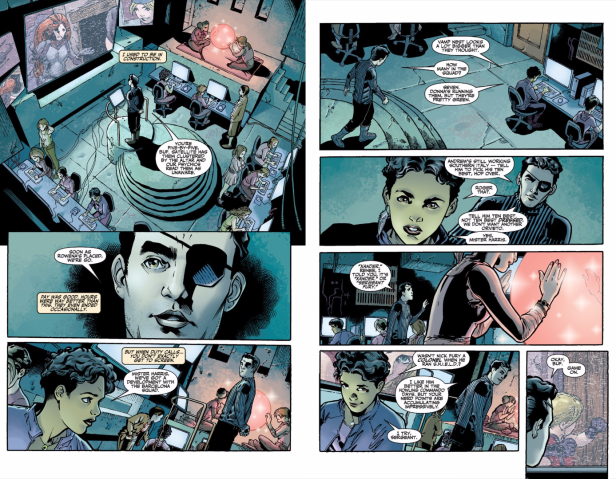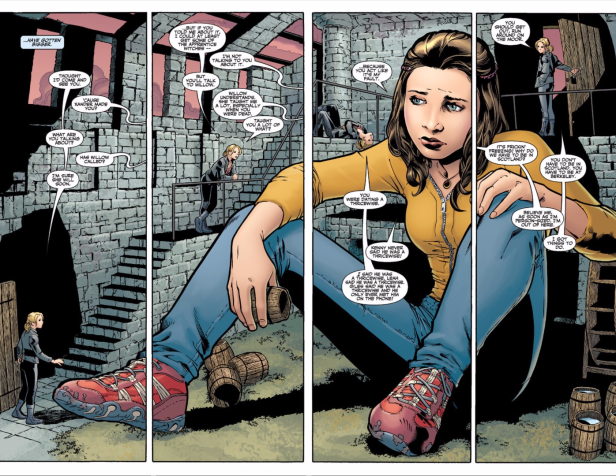Scroll through any number of “Greatest TV Shows for Geeks” lists and you’ll find a handful of shows by a single creator: Joss Whedon. The man who is, arguably, best known to the general public for co-writing and directing the first two Avengers movies made his name creating several TV shows that people still buzz about. From the short-lived Dollhouse to the even shorter lived Firefly, fans hail Whedon for his snappy dialogue, but also his whip-smart pop culture references and deep character work.
While I’ve seen enough of his work to consider myself a fan, none of his works will be able to top Buffy the Vampire Slayer. The seven-season show told the story of Buffy Summers, the fated “slayer” who, imbued with great powers, had to balance saving the world with her own personal life and struggles. There was something about the blending of both grandiose, world-saving stories with smaller character moments that connected with me in a way many shows don’t.
But like most fans, I thought the finale was just okay. It was rushed, slightly unfocused, and utilized digital effects that don’t hold up close to two decades later. Realizing that finale wasn’t what it could have been, and wanting to explore the world further, Whedon, along with several other writers on the show, teamed up to keep Buffy’s story going in a Season 8 that pushed Buffy into new territory while still remaining (mostly) true to the core DNA of the show.

The new season, spanning forty issues plus a handful of specials, saw Buffy now working as the leader of an army of fully-powered slayers. With friends Xander and Willow by her side, Buffy struggled with still feeling like a kid and having to be a leader to the girls and women looking up to her. But Buffy also had to deal with new and old threats alike, from the return of Warren Mears and the U.S. military fearing Buffy’s powers to the new, superpowered Twilight (perhaps a nod to another, lesser story about vampires), who eventually becomes the main villain for Buffy to face down.
What made Season 8 stand out so much was the fact that so many writers from the TV show came along to write for the comic. Many times, if a movie or television series gets a comic book adaptation, it feels less like a continuation and more like a certain creator’s take on the source material (think of the classic Star Wars comics Marvel put out in the seventies and eighties). But with Whedon, serving as both writer and “executive producer” of the book, Season 8 felt like it could have been airing on the WB and no one would have known the difference.
While Whedon wrote plenty of the series – he alternated between key story arcs and small one-issue stories – the other writers that joined him included Drew Goddard, Jane Espenson, and Steven S. DeKnight, who would all go on to make names for themselves outside of Whedon’s long shadow. This bevy of TV talent also included comic book pros who had never worked on the show, including such names as Brian K. Vaughan (Saga) and Jeph Loeb (Superman/Batman). The talent helped make the book not just a good continuation, but a fine comic book in it of itself. Later series featuring these characters (Buffy is now up to Season 11, along with new books for Faith, Angel, and Spike) don’t have the same high-profile talent attached, and Whedon no longer writes for the series, but Season 8 still stands as the pinnacle for the “Buffy-verse” comic book line.

With all the alumni from Buffy the TV show working on the book, it’s no surprise that all of the characters felt and sounded just like they did on the show. Obviously the focal point was Buffy, still carrying the same spunky attitude Sarah Michelle Gellar brought to her over the course of seven years. Only now there was more of a reflective side to the character. No longer could she just be the lone warrior with only a handful of people to watch out for. Now she was the leader of an entire army. Whedon and company brought her inner turmoil to the forefront, expertly balancing both the world-weary Buffy with the vulnerable kid who still questioned every decision she made.
Alongside Buffy there were the obvious mainstays, along with fan-favorite secondary characters. Willow and Xander both carried new status quos between them and held onto the same snappy dialogue they had always had. But scenes between them carried new weight as the writers reflected on the many challenges these kids had faced over the years. From Xander’s traumatic loss of his eye to the death of Willow’s girlfriend Tara, the past weighs heavily on even the smallest interactions between the “Scooby Gang” – as it would with anyone.
Everyone who returned, from Giles and Faith to Dawn and Spike feel just like they did on the TV show. A huge selling point for anyone wanting more stories with these characters after all this time. The only flaw here is that Season 8 relies heavily on having seen the entire runs of both Buffy and Angel. While this won’t be a bother to most fans, I hadn’t seen all of Angel when I first read the series, and was a bit lost on some of the content related to those characters.

The main issue that I had with the way the writing was handled with the book was the way the creators approached the idea of having an “unlimited budget” to work with. While before they had to hold back on some story ideas in order to not blow through the money they had to produce the series, now they could do whatever their minds thought up. While this was an interesting idea initially, with huge monsters that the show wouldn’t have been able to pull off, later story arcs involve characters gaining superpowers and travelling through time.
Admittedly this was an interesting idea for fans to experience, but it slowly ensured that an intrinsic element of Buffy was lost; the small-scale feel of it all. Buffy was always relegated to being inside the confines of Sunnydale, often spending half an episode inside Giles’ library to figure out how to save the day. Here, Buffy and her friends jet-set across the globe and travel to different dimensions while going through the same motions they did on the show. Visually it’s more compelling. Story-wise though, something gets lost in the expansion.

Speaking of the visuals, the art manages to work so well that it captures the look and feel of the TV series just as well as the writing picks up on the dialogue (a common theme of the construction of the book, as you might be picking up). The main artist of the series, Georges Jeanty, does a great job of not only capturing the likenesses of the actors that played these characters, but also imbuing his own sense of style onto the world. There’s a fun blend of both the horror tropes Buffy trafficked in, the twisted faces of the vampires and Gothic settings characters would find themselves in, mixed together with elements of sci-fi and fantasy that the show never really explored.
Readers see everything from future technologies to a country estate rendered in this book and it all looks stunning. Despite feeling a bit excessive at times, there’s never a moment when the art makes you feel like you’re missing something. Even the action scenes, particularly the brutal first encounter between Buffy and Twilight (whose design feels very fitting for a comic book) feels like the kind of brutal fight the show utilized at plenty of opportunities. Some superhero books can lose readers in the way artist draws a fight scene. Season 8 never has that issue.

It’s not a perfect series, but following up a great show is always a challenge. Just look at all of the remakes and reboots of classic TV shows being produced now; none of them really match the greatness of the original. But if you’re a fan of the Buffy-verse and want more stories with Whedon at the helm, then you won’t do much better than Buffy: Season 8.
Buffy the Vampire Slayer: Season 8 is available now in single issues, trade paperbacks, and deluxe hardcover collections.
